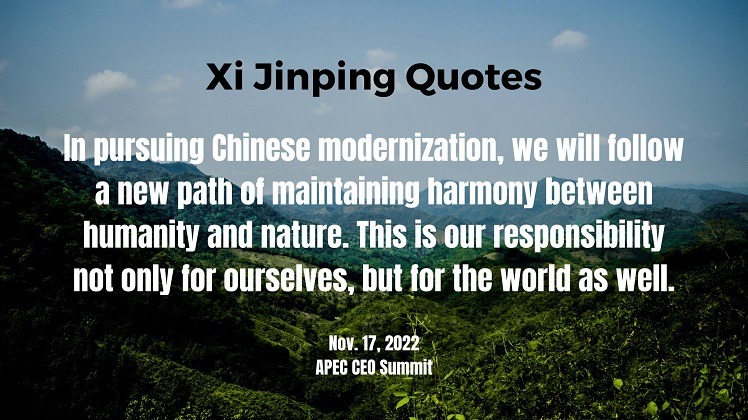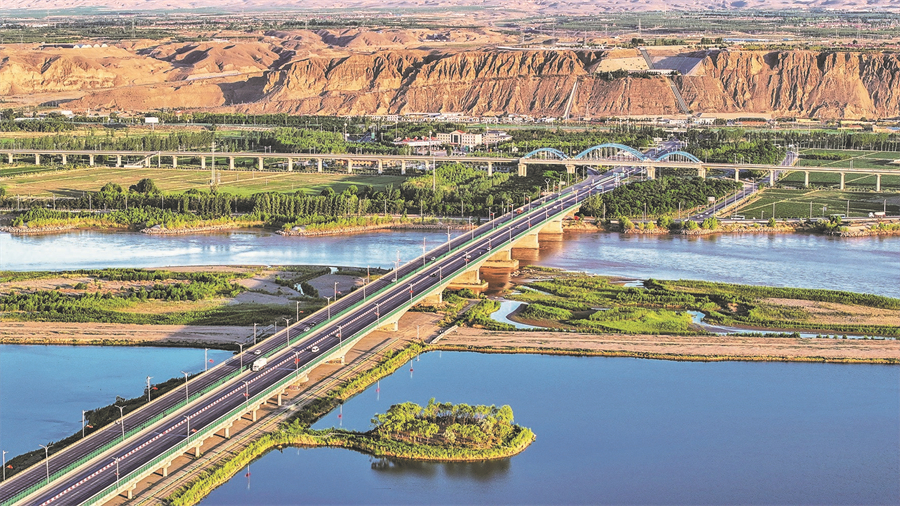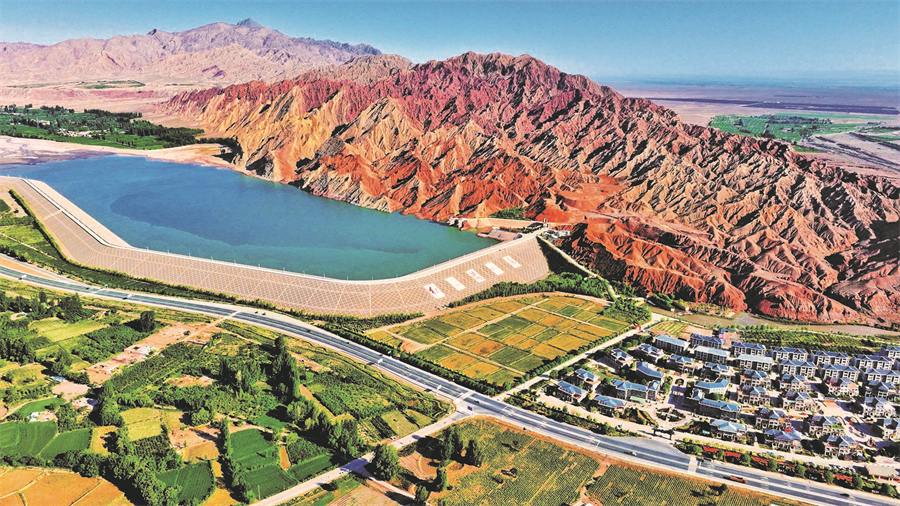
Promoting Harmony Between Humanity and Nature in Modernization by Advancing the Beautiful China Initiative.
The following article was written by the Ministry of Ecology and Environment of China, and appeared in Qiushi Journal, a bi-monthly journal published by the CPC Central Committee.
I. Innovations in Xi Jinping thought on ecological conservation
In his speech at the National Conference on Ecological and Environmental Protection on July 17, 2023, President Xi Jinping summarized China’s incredible achievements in ecological conservation that have captivated the world, particularly the historic, transformative, and comprehensive changes that have taken place. He also expounded the major relationships that need to be handled skillfully to promote ecological conservation on the new journey ahead, set out the important measures being taken to advance the Beautiful China Initiative (BCI), and explained the main requirement of upholding and strengthening the CPC’s leadership over ecological conservation. These can be summarized as the “four transformations,” “five relationships,” “six measures,” and “one requirement.”
The “four transformations” are a systematic summary of achievements, as well as a synopsis of theoretical, institutional, and practical innovations, in ecological conservation in the current era
President Xi noted, “By starting with addressing prominent ecological and environmental issues, focusing on combining work on selected spots with that of overall areas, and addressing both symptoms and root causes, we have achieved a significant transformation from remediation of major issues to systematic governance. By maintaining the change of mindset and making sure that responsibilities were fulfilled, and continuously strengthening the consciousness and initiative of the whole Party and the entire nation to promote ecological conservation, we have realized the transformation from passively responding to ecological issues to taking proactive actions to address them. By keeping abreast of the times, adopting a global perspective, and shouldering our responsibilities as a major country, we have succeeded in the transformation into a leader from a participant in global environmental governance. By constantly deepening our understanding of the laws regarding ecological conservation, we have brought about the transformation of our thinking to the thought on socialist ecological civilization with Chinese characteristics for a new era, realizing a major shift from practical-exploration-based conservation to the one with theoretical guidance.” These four transformations encapsulate the concepts, achievements, and experiences of the Central Committee of the Communist Party of China (CPC) with Xi Jinping at its core in promoting ecological conservation, including the strategic measures adopted, the transformative practices developed, and the breakthroughs and milestones achieved. They are the results of the guidance provided by Xi Jinping thought on ecological conservation, and they enrich this important thinking with some significant and original achievements.

The “five relationships” reflect Marxist thinking on materialist dialectics and represent the CPC’s deepened understanding of the laws of ecological conservation
President Xi emphasized, “China must adhere to the thought on socialist ecological conservation with Chinese characteristics for a new era and properly handle several key relationships when continuing its endeavors in ecological conservation.” First is the relationship between high-quality development and a high standard of environmental protection. This occupies an overarching and leading position and has implications for the foundations and the bigger picture of our development. It emphasizes that through high-standard environmental protection, we can constantly create new drivers and advantages in development as well as continue to enhance our potential and sustainable development. Second is the relationship between key tasks and coordinated governance. This applies systems thinking to the specific practice of ecological conservation, and it is the embodiment of the ideas of focusing on key breakthroughs and advancing all aspects of work. It emphasizes the adoption of robust measures to address prominent environmental issues and the coordinated advancement of efforts to cut carbon emissions, reduce pollution, expand green development, and pursue economic growth, while ensuring that ecological conservation efforts permeate all regions and all aspects and stages of development. Third is the relationship between letting nature restore itself and pursuing human restoration efforts. This combines respect for the laws of nature with the practical requirement to protect and restore ecosystems, with the emphasis on using both natural and artificial methods. Policies must also be tailored to suit local conditions and current situations, with stringent efforts made to find optimal solutions to protect and restore ecosystems. Fourth is the relationship between external constraints and internal momentum. This embodies the dialectical unity, interconnectedness, and mutual transformation of external and internal factors. It emphasizes using the strictest system and strictest rule of law to protect the environment, while transforming the idea of building a beautiful China into the conscious actions of all people. Fifth is the relationship between our commitment to reaching peak carbon and carbon neutrality and independent actions. This reflects the unity of stability and progress. It emphasizes that our commitment to reaching peak carbon and carbon neutrality is unwavering but that the path, method, pace, and intensity of achieving these objectives will be decided by us and not influenced by others. These five relationships contain profound dialectics, strategic approaches and paths, and systematic methods of thinking for promoting ecological conservation and advancing the BCI in the new era which began in 2012 and on the new journey ahead. They consist of original theoretical concepts and philosophical wisdom and are the concentrated expression of innovations, developments, and achievements in Xi Jinping thought on ecological conservation.

The Yellow River highway bridge, railway bridge, and wetlands interweave to create a spectacular sight in Zhongwei, Ningxia Hui Autonomous Region, June 13, 2023. China’s achievements in ecological conservation have attracted worldwide attention in the new era, becoming an important hallmark of the historic progress and changes in the work of the CPC and the country in this period. PEOPLE’S DAILY / PHOTO BY CHAI GENGLI
The “six tasks” clearly define the key work involved in advancing the BCI and implementing the plans proposed at the 20th CPC National Congress
At its 20th National Congress, the CPC presented an ambitious blueprint for building China into a modern socialist country and advancing the rejuvenation of the Chinese nation via a Chinese path to modernization, including to “broadly establish green ways of working and living; steadily lower carbon emissions after reaching a peak; fundamentally improve the environment; largely accomplish the goal of building a Beautiful China,” by 2035. The CPC also set out plans concerning “pursuing green development and promoting harmony between humanity and nature.” In his speech at the National Conference on Ecological and Environmental Protection, President Xi enumerated the six tasks: to intensify the battle against pollution; to accelerate the shift to a green and low-carbon development model; to boost the diversity, stability, and sustainability of our ecosystems; to actively yet prudently advance the objectives of reaching peak carbon and carbon neutrality; to ensure the advancement of the BCI; and to improve the systems for guaranteeing advancement of the BCI. These six tasks are strategies for implementing the decisions and plans of the 20th CPC National Congress and advancing the BCI over the next five years and by 2035. They serve as a program of action and guide for advancing the BCI.
The “one requirement” is the anchor of ecological conservation and a fundamental guarantee for advancing the BCI on the new journey ahead
President Xi has stressed that advancing the BCI is an important objective of building a modern socialist country and that the CPC’s overall leadership must be upheld and strengthened. The environment is a major political issue which bears upon the mission and purpose of the CPC. The CPC leads the people in developing the country and creating a better standard of living, and it champions the cause of ecological conservation. Since the 18th CPC National Congress held in 2012, the CPC Central Committee has focused on ecological conservation more than ever before, engaging in fundamental, pioneering, and long-term work in the areas of mentality, law, systems, organization, and work style to make historic achievements and changes. Experiences in the new era have shown that the CPC’s leadership fundamentally guarantees the continued success of ecological conservation.
II. Impressive results in ecological conservation
China has worked hard to make great achievements and tremendous changes in its environment, ecological conservation, green development, institutional framework, and global contributions, resulting in bluer skies, greener land, and clearer waters across the country.
Environmental quality
The average concentration of PM2.5 in cities at and above the prefectural level across China has fallen to 29 µg/m3, while the average concentration has decreased 57% and the number of days of heavy pollution has decreased 93% in key cities, meaning that China has achieved the fastest improvement in air quality in the world. The proportion of surface water meeting good or excellent water quality standards (Grade I-III) has risen to 87.9%, which is close to the standards of developed countries. Black and odorous water bodies in cities at and above the prefectural level have been basically eliminated. The main stem of the Yangtze River has reached the Grade II water quality standard along its entire course for three consecutive years, and the main stem of the Yellow River achieved the Grade II water quality standard along its entire course for the first time. The proportion of coastal waters across the country achieving good or excellent water quality standards has increased by 17.6 percentage points. Soil environmental risks have been effectively controlled, and China has achieved its goal of zero imports of solid waste on schedule, resulting in a cumulative reduction of 100 million tons of solid waste imports.
Ecological conservation
Control of desertification has been implemented on 18.5 million hectares of land, measures to improve pasture have been taken on 40 million hectares of land, and China is a global leader in reducing desertification and sandification. The areas of nature reserves and ecological conservation redlines account for 18% and 30% of China’s total land area, respectively. A total of 68 million hectares has been afforested. Forest coverage has risen to 24.02%, giving China the largest and fastest growing forest resources and the largest area of cultivated forests in the world, with 87.6 million hectares of preserved cultivated forests. China’s total forest coverage and forest stock have both increased for more than 30 consecutive years. The first batch of five national parks has been established, and China’s first national botanical garden and first seed bank have been developed. The wild populations of more than 300 rare and endangered wild animals and plants have also increased steadily.
Green development
Average annual growth of 3% in China’s energy consumption has supported average annual economic growth of more than 6%, and China has achieved a cumulative reduction in energy intensity of 26.4%, one of the fastest reductions in the world. Carbon intensity has fallen by a total of more than 35%, reversing the trend of rapid growth in carbon dioxide emissions. China has built the world’s largest carbon market and clean power generation system. Coal’s proportion of total energy consumption has fallen to 56.2%, while that of clean energy has increased to 25.9%. Installed renewable energy capacity accounts for 47.3% of China’s total national installed power generation capacity, exceeding the installed capacity of coal. China leads the world in installed capacities of hydropower, wind power, solar power, and biomass power. China has also ranked first in the world for production and sales of new energy vehicles for eight consecutive years.
Institutional framework
China has formulated dozens of reforms on, and largely established the basic institutional framework for, ecological conservation. It has established sound systems for the assessment and accountability of ecological conservation objectives, river and lake chiefs, emissions permits, ecological conservation redlines, and the arrangement that makes Party committees and government agencies both responsible for environmental protection and all officials assume responsibility for environmental protection in addition to their prescribed duties. Two rounds of strict central environmental protection inspections have proved effective at encouraging local Party committees as well as governments and their relevant departments to take genuine responsibility for environmental protection. Amendments have incorporated ecological conservation into the national Constitution, the Civil Code has established a “green principle” for civil activities, an amendment to the Criminal Law improved provisions on environmental pollution offenses, and a “1+N+4” socialist legal system for environmental protection has been developed, consisting of more than 30 relevant laws.

Tibetan wild donkeys on the Altun Mountains National Nature Reserve, Xinjiang Uygur Autonomous Region, June 30, 2023. Enjoying an increasingly rich biodiversity, the nature reserve is home to 17 of China’s Class I protected animal species, including the Tibetan wild donkey, wild yak, Tibetan antelope, Tibetan gazelle, pika, and black-necked crane. PHOTO BY XINHUA REPORTER CAI YANG
Global contributions
From the lofty perspective of our sense of responsibility to human civilization, we proposed building a community of all life on Earth and working together to create a cleaner and more beautiful world. We have backed the implementation of the Paris Agreement and made a solemn commitment to achieving peak carbon and carbon neutrality. China, which was in the chair as president, successfully hosted the 15th meeting of the Conference of the Parties to the Convention on Biological Diversity (COP15). It led to the adoption of the ambitious yet pragmatic Kunming-Montreal Global Biodiversity Framework, which drew widespread praise from the international community. China has developed the Belt and Road Initiative International Green Development Coalition and launched the Initiative for Belt and Road Partnership on Green Development with 31 participating countries. China has also proactively engaged in South-South cooperation to address climate change.
III. Current developments in ecological conservation
China’s socioeconomic development has entered a stage of increasingly green and low-carbon high-quality development, but ecological conservation remains in a critical period of overlapping pressures and onerous tasks.
Chinese modernization seeks harmony between humanity and nature despite our huge population
China’s per capita resources are far below world averages, though it manages to support nearly 20% of the world’s population with just 9% of the world’s arable land and 6% of the world’s freshwater. It is essential that modernization and common prosperity include all of China’s 1.4 billion people, which creates tremendous pressure to overcome our resource and environmental constraints. Should we follow the old European or American routes, the resources of several Earths would be insufficient. When it comes to socioeconomic development plans and ecological conservation work, our huge population must form the basis of all our decisions.
Chinese modernization seeks harmony between humanity and nature despite onerous tasks of transforming our industrial and energy structures
China’s green and low-carbon development level remains low, and some structural pressures have yet to be fundamentally resolved. The proportion of traditional industries remains high. China produces and consumes more than half of the world’s iron and steel, cement, electrolytic aluminum, and other raw materials, and our resource and energy utilization efficiency is low. Our energy demand is still growing, and coal still accounts for more than half of our total energy consumption. Our reliance on heavy industry and coal cannot be reversed overnight. Road freight accounts for as much as 73% of total freight transport, which produces large volumes of pollutants and suspended dust from road surfaces. China still uses many medium- and heavy-duty diesel trucks, which are the main source of mobile pollution. Furthermore, the green transformation of our socioeconomic development lacks internal drivers and has weak foundations.
Chinese modernization seeks harmony between humanity and nature despite stubbornly high pollution and carbon emissions
On the whole, we still lack the solid foundation required for stable and long-term improvements in the ecological environment, with the turning point from quantitative to qualitative change being still some way off. Air quality continues to be subject to meteorological influences, and more than a third of cities in China do not yet meet air quality standards, with PM2.5 levels three times as high as the average levels in Europe and the United States. Prominent issues remain with water ecosystems, particularly lake ecosystems, which are severely imbalanced. Soil pollution is continuing to accumulate in some regions. The proportion of areas with moderate or greater ecological vulnerability is high, there are prominent issues with the quality and functions of local ecosystems, and biodiversity loss has not yet been brought under control. China also faces huge challenges to achieve peak carbon and carbon neutrality in the near future.

The Hongshanwan Reservoir blends with the surrounding Danxia landscape to form a striking picture of ecological harmony in Linze County, known as the “water town of the Gobi Desert,” Gansu Province, June 15, 2023. Thanks to persistent efforts since 2012, China has enjoyed bluer skies, greener lands, and cleaner waters, adding yet further beauty to its stunning natural environment. PEOPLE’S DAILY / PHOTO BY WANG JIANG
Chinese modernization seeks harmony between humanity and nature despite past environmental debts remaining unsettled
Over time, China has accumulated many entrenched ecological and environmental issues. There are also considerable inadequacies in environmental infrastructure, with poor maintenance of new facilities and an urgent need to update old facilities. There are still notable shortcomings in the construction of sewage networks in old urban communities, urban villages, and urban-rural fringes, and higher rates of domestic sewage treatment are needed in rural areas. The incineration and treatment of domestic waste in county-level areas is substandard. There are nearly 10,000 tailings ponds across China, which pose obvious risks and hazards. A large volume of solid waste has accumulated over time, and we are lacking capacity in the disposal of hazardous and medical waste.
Chinese modernization seeks harmony between humanity and nature despite the growing complexity of global environmental governance
The world is in a new period of turbulence and change, including global food and energy security issues, badly affected industrial and supply chains, and a growing backlash against globalization. As a result, China faces a consistently unstable and unpredictable external environment, the challenges in global environmental governance have expanded, and dealing with international games in the area of the ecological environment is formidable. Intense negotiations are taking place over climate change and biodiversity, with some countries pressuring China to take on responsibilities beyond our stage of development and capacity. Some Western countries are playing the climate card to introduce carbon tariffs and other policies that will undo China’s achievements in its shift toward green and low-carbon development, and there is growing politicization of global environmental issues.
Chinese modernization is a parallel process, with industrialization, informatization, urbanization, and agricultural modernization occurring simultaneously, and with various issues from various stages and across various fields becoming intertwined and appearing at once. Achieving modernization featuring harmony between humanity and nature involves time-space compression, complex tasks, and immense pressures. It is necessary to both prevent and control environmental pollution and shift to green and low-carbon development, while also boosting the protection and restoration of ecosystems. We must remain clear-headed, maintain strategic resolve, withstand difficulties and press ahead to make our goal of advancing the BCI a reality.
IV. Vigorously advancing the Beautiful China Initiative
Fulfilling our political responsibilities in ecological conservation
We will ensure that both Party committees and government agencies assume responsibility for implementing ecological conservation and that all officials take responsibility for it in addition to their prescribed duties. We will also ensure that the responsibilities of departments for ecological conservation are implemented assiduously. We will establish sound systems and mechanisms for the implementation of the BCI and organize evaluations of the BCI’s effectiveness. We will take strict steps and adopt a problem-oriented approach to continue to leverage the powerful role of central environmental protection inspections and encourage the implementation of major decisions and plans of the CPC Central Committee. We will also strengthen law enforcement and supervision, investigate and deal with environmental pollution and ecological damage in accordance with the law, and be good guardians of the ecological environment.
Further improving environmental quality
We will continue to control pollution in a targeted, systematic, and lawful manner; never let up in our efforts, but rather expand and intensify them; and make progress in the battles to keep our skies blue, waters clear, and lands clean. Focusing on controlling PM2.5, we will strengthen the coordinated control of multiple pollutants and regional pollution as well as integrate the management of water resources, water environments, and water ecosystems. We will bolster control over sources of soil pollution, step up comprehensive management of solid waste and management of new pollutants, and constantly increase people’s sense of fulfillment, happiness, and security toward the ecological environment.
Shifting to a green and low-carbon development model
Starting with reductions in pollution and carbon emissions, we will accelerate the formation of spatial layouts, industrial structures, modes of production, and ways of life that are conducive to resource conservation and environmental protection. We will fully implement the system of adopting region-specific approaches to environmental management. We will improve economic policies related to green and low-carbon development and accelerate the construction of an environmental protection credit rating-based supervision system. We will standardize the environmental governance market and promote the healthy development of environmental protection industries and environmental services. We will support work in response to climate change and improve the market for carbon emission trading. We will promote ecological conservation and stimulate momentum within society for concerted environmental protection efforts.
Protecting and restoring ecosystems
We will adhere to a holistic and systematic approach to the protection and conservation of mountain, waters, forest, farmland, lake, grassland, and desert ecosystems. We will advance major projects on protecting and restoring important ecosystems and establish a sound nature reserves system. We will improve the regulatory system for, and carry out assessments on the effectiveness of, the protection and restoration of ecosystems. We will also carry out major biodiversity protection projects and proactively implement the Kunming-Montreal Global Biodiversity Framework, in order to promote global biodiversity conservation.
Safeguarding eco-environmental security
We will pursue a holistic approach to national security, manage environmental risks timely, and enhance national research and assessments, monitoring and early warning, and emergency response and handling capabilities for ecological security risks. We will promote the investigation and remediation of environmental risks in key areas, such as hazardous waste, tailings ponds, harmful chemicals, and heavy metals. We will guide local governments in handling major and sensitive environmental emergencies properly and continue to promote response capacity building for environmental emergencies. We will continue to adopt a rational, coordinated, and balanced approach to nuclear security, tighten supervision of nuclear and radiation safety, and upgrade our oversight capacity, in order to ensure that there are absolutely no missteps with our nuclear and radiation safety.
Modernizing environmental governance
We will encourage the formulation and revision of laws and regulations in key areas. We will deepen the reform of vertical management of the monitoring, supervision, and enforcement activities conducted by environmental protection agencies below the provincial level and ensure primary-level environmental departments are able to fulfill their duties. We will expand applications of AI and other digital technologies to improve environmental oversight and implement major initiatives on eco-environmental technological innovation. We will integrate Party development and professional capacity building and put together a strong environmental protection team composed of capable and uncompromising members with strong political consciousness and a willingness to take on responsibility.
Source: Qiushi Journal (English Edition), 2023-11-14. http://en.qstheory.cn/2023-11/14/c_938615.htm .(Originally appeared in Qiushi Journal, Chinese edition, No. 15, 2023)